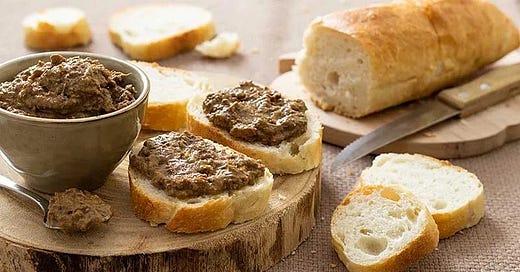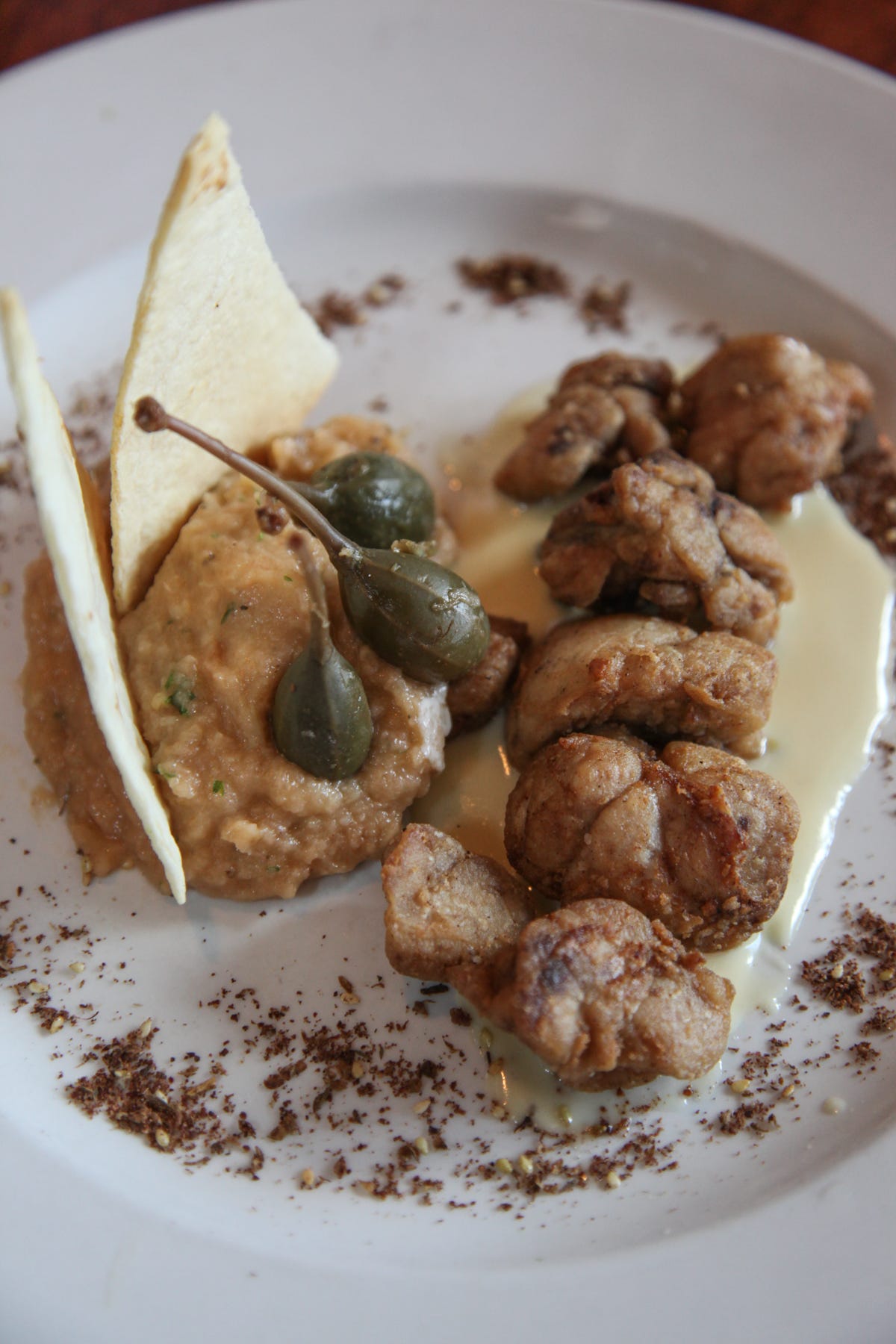The Food of the Gods or Forbidden Pleasures?
We real foodies attach biblical status to something as primitive as organ meat or offal. Heavenly or Devilish—which is it?
Offal is the category of animal cuts that are, in the supermarket at least, the dregs, the least desired part of an animal. A huge percentage of this nutritious food now ends up in preformed burgers, hot dogs, animal food and other products. Ever wonder what is meant in the advertising campaign “100% Beef” ? Is it Sirloin? Filet? I doubt it. Try lungs and hooves. Yes, that is the way most Americans get their lesser cuts. When I was a starving artist in the late 70’s, I had a temp job at a meat processing plant. They had bright yellow carts with “Hot Dogs” scrawled in black marker on the sides for every single scrap, organ and tendon not destined for the standard supermarket selection. If I knew then what I know now...I could have created a gustatory paradise from that cart’s contents.
Sweetbreads, Pates, Marrow Custard and Anticuchos are considered specialties in many parts of the world, reserved for the both traditional and refined, sophisticated eaters. James Beard and Julie Child, icons in the American culinary revolution, revered a good chicken liver appetizer or kidneys in sweet and sour sauce. But to mention these items many today in America, and you will receive a groan or my least favorite response --- eeeuuwwwe, gross! In a case of mistaken identity, offal, variety meats and many “good fats” have been much maligned in the modern food media, until recently that is.
The good news is that Chefs have rediscovered “Variety meats” and offal. By Variety meats I mean heart ( it is not an organ, but a muscle), cheeks, neck and feet and by offal I am referring to any and all organs including brains, sweetbreads, liver, spleen, testicles...you get it. Chefs enjoy working with these delicacies for a few reasons. First of all, they are unique and delicious. The layers of complexity, the nuances of mineral and floral aromas, layers of subtle sweetness and bitterness, the supple texture---these are the same descriptions we use for fine wine. This is the good stuff, not the house pour, and chefs like that!
The second reason is that chefs need variety to show off their creativity. After cooking hundreds of predictable and sometimes boring filet mignon specials, chefs need to explore new things to keep their edge and offal is a great opportunity for that.
The array of unique flavors make offal some of the best and most intriguing ingredients play with when creating exciting wine pairings as well. There are a myriad of preparation styles for offal that pair with wine, from lemon-caper sauces for veal sweetbreads to be paired with creamy white wine, to grilled beef heart paired with a deep, dark red, to melty, sticky pork cheeks paired with a complex aged riesling, these are the toys of a creatives chefs and sommeliers alike.
Another reason why offal is making a comeback in restaurant kitchens is because of the global influence on modern chefs. Organ meat is still revered in all, I mean ALL parts of the world except America, where we think that a boneless skinless chicken breast has flavor. From Asia to Argentina livers, kidneys, tongue, heart, and more are relished by the rich and poor alike. In my travels to Europe, Central and South America, the most memorable meals I have had included some form of “forbidden pleasure”. It is what the locals encourage you to enjoy, as a way of making a connection and creating a bond with our cultures.
Organ and Variety meats from naturally pastured animals are, contrary to contemporary myth, quite healthy for you. They contain many elusive nutrients, minerals, “good” fat, cystine, elastin, collagen and other enzymes that are essential to the development of our own organs, joints, brain and blood. According to bone and fat enthusiast Jennifer McLagan, author of James Beard Award-winning cookbook Fat, “marrow is full of minerals and good fat. Queen Victoria ate marrow every day and, while she may have had a full figure, she lived to be 81." Of course, that was when life expectancy was much shorter than today. Studies back her claim up, showing that marrow is a good source of protein and is high in monounsaturated fats, which decrease bad cholesterol levels.
Finally, using every part of the entire animal is the essence of the sustainability movement. If all we demand is round cutlets that fit perfectly on a bun, the processing industry will continue to develop “Franken-meat” to fulfill our desires. We are what we eat and we get what we ask for! Please step outside the boneless breast circle and help local farmers steward their land by enjoying the entire animal in all its gastronomic glory. To be sensible and sustainable in our meat choices, we must honor and use the entire animal in a holistic way. Use it all, cook it all, serve it all and eat it all and in the words of the immortal Julia Child “Save the liver!!!”
To find out about my 2024 Sicily and Central Italy Experience tour schedule, pop up dinners and cooking classes, visit https://ricorlandocom
Follow me on all Social Media at chefricorlando







Great piece. I recently started buying ground beef from a Mennonite farmer in PA. It includes liver and various other organ meats in the blend. What a reminder of what hamburger used to taste like when I was a child (some 70 years ago)! I am delighted to hear you also sing the tasty praises of organ meats.